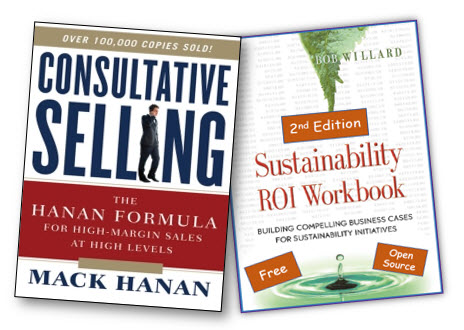3 Consultative Selling Questions Answered by the “Sustainability ROI Workbook”
 I had a catch-up lunch with a former IBM colleague recently. As we updated each other on our current activities, I couldn’t resist asking him how he would recognize a good business case if he saw one. “Easy,” he said. “It answers three questions: How much? How soon? How sure?”
I had a catch-up lunch with a former IBM colleague recently. As we updated each other on our current activities, I couldn’t resist asking him how he would recognize a good business case if he saw one. “Easy,” he said. “It answers three questions: How much? How soon? How sure?”
Impressed by the speed of his reply, I asked if he made those questions up on the spot, or if he had used them before. I was somewhat relieved that it was the latter. He was quoting Mack Hanan’s three consultative selling questions advocated in his book, “Consultative Selling: The Hanan Formula for High-Margin Sales at High Levels.” We then chatted about whether those questions would be on the mind of a Chief Financial Offer (CFO) when asked to approve an environmentally or socially beneficial project and agreed that they would be. Fortunately, the Sustainability ROI Workbook helps frame the answers for all three questions for projects that have environmental and social benefits.
How much?
- The workbook details how much one-time capital expenditure is required to do the project, and its sources.
- It provides a worksheet that captures how much revenue growth might result from the project, fueled by an enhanced reputation with customers who care about sustainability issues and prefer to deal with companies whose values resonate with theirs.
- It identifies how much 13 operational expenses will be reduced by the project, and any associated ongoing additional operating expenses.
- It provides a way to estimate how much hiring and attrition expenses may be reduced because of employee support for company efforts on environmental and social issues that they care about, and how much productivity benefit results from employee’s higher level of engagement because they are energized by company efforts on issues that are important to them.
- Its financial analysis automatically calculates how much more profitable the company will be, the internal rate of return on the capital invested in the project, and the net present value of future positive cash flows resulting from the project.
- It captures how much the value of company assets like buildings and equipment will be increased by the project, and how much the company’s market capitalization may be increased because of investor interest in the company’s positive sustainability impacts.
- Finally, it helps users estimate how much revenue, operating expenses, employee-related expenses, asset values, and market value could be at risk if the project is not undertaken.
How soon?
- The workbook automatically calculates the payback period for the project, which is the traditional indicator of how soon the original investment in the project is paid back by its resulting annual positive cash flows.
- The project description includes a start and end date for the project. Simple.
How sure?
- This is a risk-related question about the need for a contingency fund or budget buffer to allow for cost over runs or other delays. The workbook includes calculations for these factors.
- This question also applies to the credibility and accuracy of the data and assumptions used in the calculations. That’s why users are strongly encouraged to co-create and the business case with internal data owners and project implementers, to supplement build-in guidance about possible improvements for many line items in the workbook, based on other companies’ experience.
The fundamentals of a good business case are similar to the fundamentals of good selling: tell the deciders what they need to know. They need to know the answers to the three questions. Happily, the Sustainability ROI Workbook helps sustainability champions provide CFO-appropriate answers to the three questions about any proposed sustainability-related project.
Bob
Please feel free to add your comments and questions using the “Leave a reply” comment box under the “Share this entry” social media symbols, below. For email subscribers, please click here to visit my site and provide feedback.



Comments are closed.